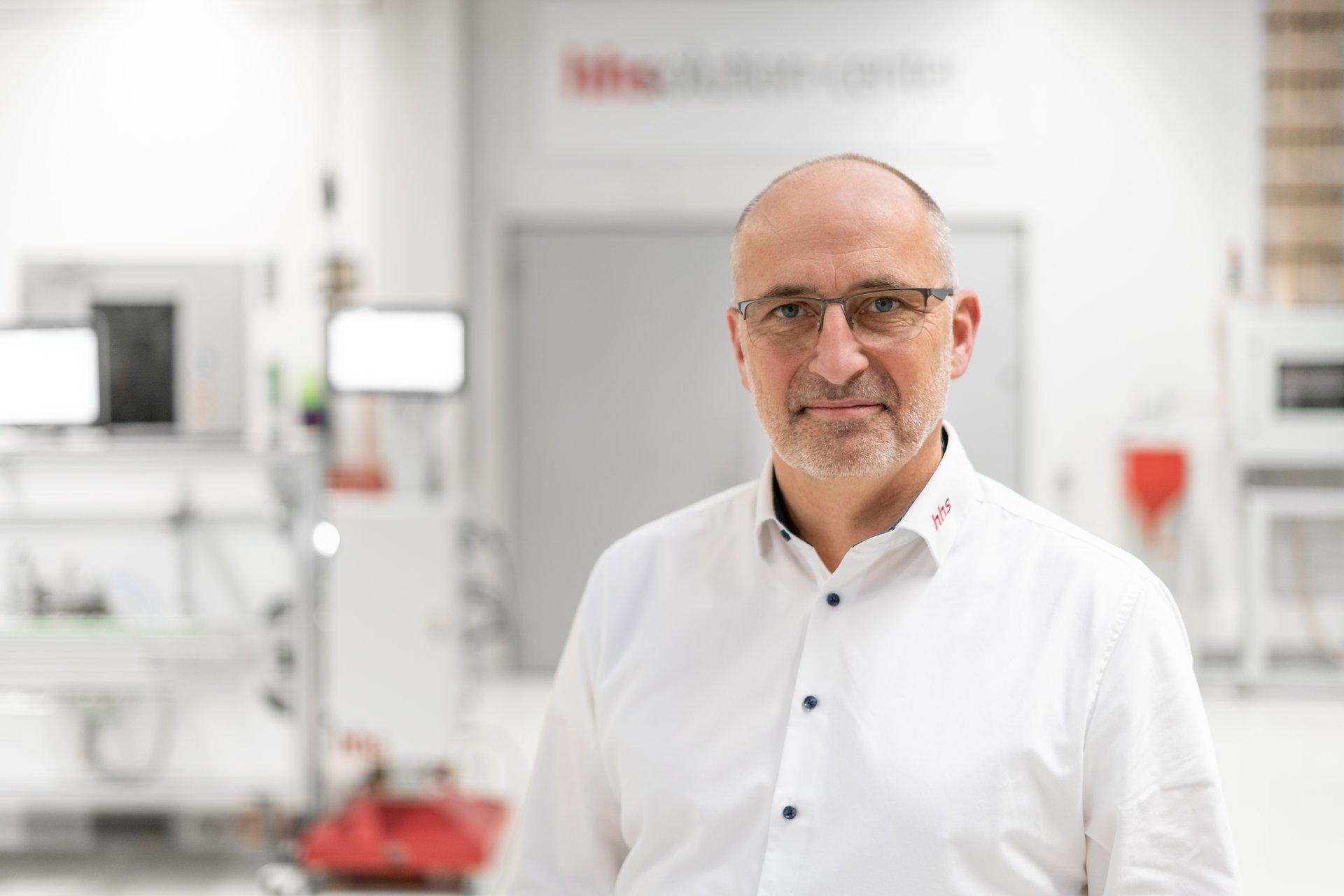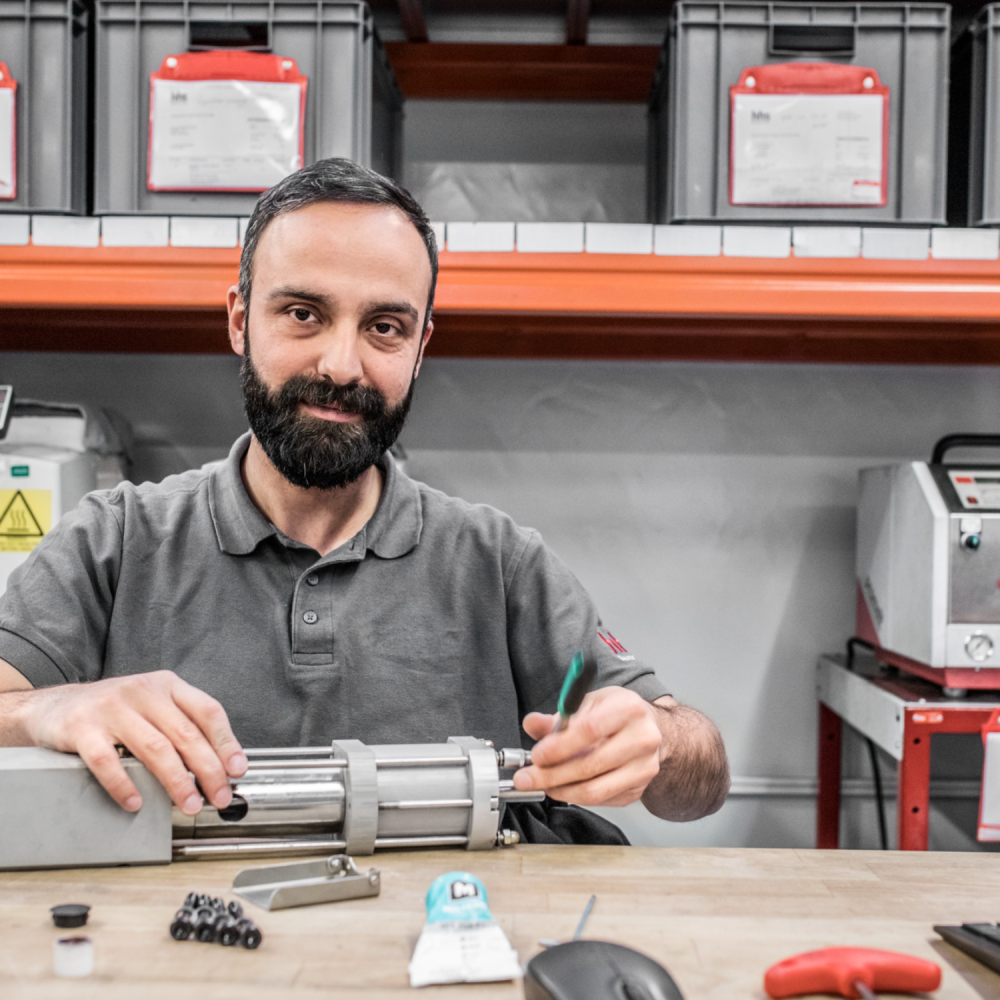Volume 04
Digital, fast, sustainable – Service is the unsung hero in the battle against resource waste
In our Eco Talks series, various people in management positions at Baumer hhs get an opportunity to share their personal insights on the subject of sustainability. In exclusive interviews, they shed light on Baumer hhs's past and ongoing steps to promote sustainability, and they explain exactly how our innovative solutions help customers to minimise their ecological footprint while making production processes more efficient. Eco Talks – Inspiring insight into sustainable innovation and responsibility.
In this episode, Baumer hhsHead of Service and After Sales Rüdiger Doll talks with Florian Lemke (Digital Content Manager) about sustainability in and through service of Baumer hhs.
Florian Lemke: Mr Doll, you have been responsible for the Customer Care department at Baumer hhs for many years. Today I would like to discuss the company’s Xcare Services with you, particularly with regard to sustainability. Let’s start with the basics: What makes Xcare so special?
Rüdiger Doll: Gladly. To us, Xcare is more than just a range of services. It is a strategy we have developed to both extend the lifespan of our systems and help conserve resources. Using technical solutions, we want to strike a real balance between ecological and economic goals – without any greenwashing whatsoever.
Florian Lemke: Greenwashing sounds like a critical issue. What does it mean exactly?
Rüdiger Doll: We don’t want to claim to be more sustainable than we really are. We’re not interested in labels; we’re interested in verifiable results. Take Quick Inspect, for instance. With this tool, we are capable of analysing a system before it is even serviced. As a result, we can avoid unnecessary visits to the customer, reduce material consumption and at the same time extend the lifespan of a machine. And that is not just something we claim to be true; it is a measurable fact.

Florian Lemke: In other words, Quick Inspect is the start of a sustainable maintenance cycle?
Rüdiger Doll: That’s right. It is a preventative step that shows the current status of a system in detail. Our technicians add photos and technical assessments to document it. This information gives us two advantages: First, our customers know exactly what is at issue. Second, we only use resources where they are really needed. By taking this approach, we increase efficiency and avoid waste.
Florian Lemke: What are the actual steps in a Quick Inspect?
Rüdiger Doll: The customer calls us in to create an inspection report. Our service technicians analyse the status of a system on-site, document special characteristics as well as any deviations, and take high-resolution photos of all the relevant components. Using this information, we provide customers with a detailed status evaluation, including recommendations for maintenance. The difference is that these recommendations are based on real data and easy to understand. This kind of transparency strengthens customer confidence in us and serves as a basis for every subsequent service decision.
Florian Lemke: What if a customer wants to evaluate a system on their own or has only minor problems? Is there a solution that doesn’t require a technician to make a visit?
Rüdiger Doll: We have an option for this scenario as well: Xcare Self Inspect. With this digital tool, customers can upload pictures and descriptions of their system. All they need is a regular mobile phone. Our experts then analyse the information and provide an initial assessment, usually on the same day. Xcare Self Inspect is a tremendous help for resolving simple problems and avoiding unnecessary on-site visits. Fewer trips mean lower emissions – another form of proactive sustainability
Florian Lemke: How easy is the Self Inspect Tool to use? And what kind of customer response is it generating?
Rüdiger Doll: It couldn’t be easier to use. All customers have to do is take a few informative photos, briefly describe the problem, complete a form, and upload the information. We promptly contact the customer and let them know if the problem can be solved remotely or if a technician needs to come out. Customers especially appreciate our fast response. Many say they feel like they are taken seriously and getting competent support. And in the end, we all save time, cut costs and reduce CO₂ emissions.
Florian Lemke: What happens if a part really is defective?
Rüdiger Doll: Then our Xcare Exchange programme takes over. We ship out a refurbished spare part within 24 hours. The customer returns the defective part, which we inspect, repair, and return to the exchange programme. This circular flow of parts avoids electrical/electronic waste and conserves raw materials. The customer receives a refurbished original part with warranty, which they can put to immediate use. Speed and sustainability need not be mutually exclusively. On the contrary, they complement one another excellently.
Florian Lemke: That sounds like a perfect circular economy. Do customers go for it?
Rüdiger Doll: Yes, absolutely! Customers like working with tested components that offer the same level of performance as new parts, but are available faster and don’t waste resources. And it’s a real win-win situation for us: We extend the product life cycle, reduce waste and help our customers get right back to work.
Florian Lemke: So your goal is not to just operate a system, but to keep it in shape for many years to come. How does your repair programme fit into this strategy?
Rüdiger Doll: It’s a seamless fit. Our repair department works on an OEM level. That means we don’t just repair a component, we restore it to full functionality and reliability, using original parts, extensive testing and all our expertise. This significantly extends the life of a system and often makes new purchases unnecessary. And if we determine that technical updates are advisable, we also integrate them directly, meaning a machine is not only functional but also state-of-the-art.
Florian Lemke: What specific steps does the repair process involve?
Rüdiger Doll: As soon as we receive a defective part, the repair process starts with a detailed analysis. We test not only the specified problem, but all of a part’s functions. Then we replace any defective or worn elements, in some cases with improved components. After a part is repaired, we thoroughly test it, often on specially developed test benches. It doesn’t leave our workshop until it functions perfectly again. Our customers get a quality product that is fully in line with Baumer hhs standards.

Florian Lemke: Can you give us any illustrative examples?
RD: There are many, but one sticks out in my mind in particular. A customer had a system that was ten years old and not running reliably any more. We didn’t just sell him a new one. We totally overhauled it, replaced worn parts, installed software updates and integrated new functions. The result: The system is up and running smoothly again – at a fraction of the cost of a new one. And without wasting resources.
Florian Lemke: Impressive. How are customers responding to this sustainable service strategy?
Rüdiger Doll: Very positively. A lot of customers are thinking about sustainability these days, not just out of personal conviction, but because it pays off economically. With Xcare, we offer transparency, predictability and real alternatives to the classical throwaway mentality. That strengthens customer confidence in us. It makes us a partner, not just a supplier.
Florian Lemke: What role does digitalisation play?
Rüdiger Doll: It plays a very central role. Our digital tools like Xcare Self Inspect, and the sensors integrated in our systems, are the foundation for our data-based services. We are talking about condition monitoring, predictive maintenance and long-term system optimisation. Those are not just buzzwords; they are the new standard. And the better our systems communicate, the more targeted is our response – precise, efficient, sustainable.
Florian Lemke: I would like to conclude with a personal question: What motivates you to develop strategies like this?
Rüdiger Doll: I believe we have a responsibility – for our customers, for our products and for the environment. Technology should not only be efficient, it should serve a purpose. When we succeed with our smart services in conserving resources, minimising downtime and helping customers achieve their sustainability goals, then we’re doing something right. That is exactly what motivates me every single day.
Florian Lemke: Thank you very much for the in-depth discussion.
Rüdiger Doll: Thank you too, Mr Lemke. I look forward to working with customers who want to join us on our sustainability journey.

